Kenjiro Suzuki bespoke, Paris: Review
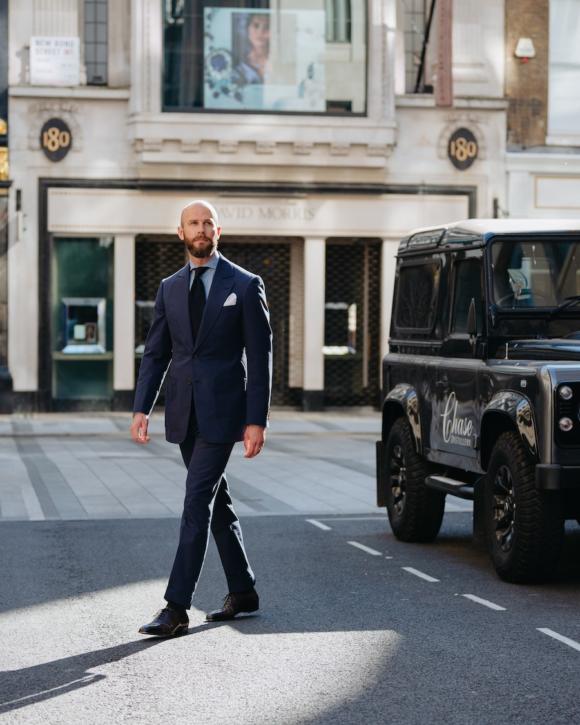
Kenjiro Suzuki is a superb technician.
I think that’s the key take away from this review, aside from the normal points of fit, style and make.
The work that went into this cotton suit he made me is just palpable, both in the handwork visible on the outside and the shape created by the work on the inside.
It is a piece of art, an example of the best that bespoke can be.
The style is not what I would instinctively go for these days, with its higher waist, shorter jacket and bellied lapels. But I know it will appeal to others. The fit is also good, and I’ll cover both those aspects in detail.
But particular attention will be given to the technical side of Kenjiro's work, its originality and its rigour.
Cotton has little drape, as I’ve said many times before, and therefore a bespoke cotton suit is never going to flow as a fine worsted would.
But still, Kenjiro has achieved a great fit. It feels sculpted to the upper body, perfectly accommodating my sloping shoulders and the curved run into the upper arm.
During our fittings and interview, Kenjiro talked repeatedly about shaping the garment, about working the cloth into a mould to encase the body. And the chest and shoulders do feel like that.
He has developed his own range of both canvas and shoulder pads, which likely helps. For my suit, he used a fairly structured canvas but the lightest pad.
He was at pains to point out that it would be much easier to use a slightly thicker pad on one side, given my right shoulder is lower than my left (most people have a similar difference). But he considers that cheating, and would always shape both sides differently instead.
The back of the suit isn’t quite as clean as the front, but most of that should be put down to the material.
And the side view shows the shape nicely, while also illustrating the slightly short length and the lack of suppression in the back. This space is a useful thing to have on cotton, as it has so little stretch; but still, it is something I might ask Kenjiro to tweak next time I see him.
It’s also worth looking at the line of the trousers in that side view. Because Kenjiro goes to extreme lengths to shape the cloth of the legs, creating an S-shape that follows the curves of the thigh and calf.
Above you can see his before-and-after photos from another customer’s trousers. He works on the trouser with an iron for about 50 minutes to achieve that shaping.
As to the difference it makes, I’m not sure anyone would notice unless it was pointed out.
They do hang very nicely for slim trousers, and never get stuck on my calves. But still it is a very subtle point.
The make of the suit elsewhere is absolutely first class. The level you would expect from a top French tailor, plus - perhaps - some extra Japanese attention to detail.
The buttonholes (below) are fine, the Milanese-style buttonhole in the lapel (above) perfect, and the edge stitching and tack stitches meticulous.
But in a few places there are also a few more stitches, perhaps smaller ones too, than on other French suits. On the back of the collar, on round parts of the lining, and on the internal work like the chest canvas (above).
The breast pocket is also particularly nice. Straight but subtly angled, with precise corners. The kind of thing a good coatmaker would appreciate (see previous post).
The in-breast pockets are also beautiful. They’re cut into the facing itself, which curves deeply around the two openings.
And they’re angled slightly: perhaps not as much as the photo suggests, but definitely with a forward slant. It looks odd, but actually functions very well.
The internal hip pocket, which also displays the brand name, is equally well executed. Though if I had to choose, I probably think the design of the Camps de Luca ‘teardrop’ pocket is more pleasing.
Returning to the canvas and pads, Kenjiro has offers four levels of canvas: classic (for most suits), softer (suit or jacket, soft style), very soft (only casual jackets) and the softest, for virtually unstructured suits.
We used the classic on my suit, as Kenjiro was particularly keen to create an attractive chest profile (which probably explains why the fit feels so good there). He also usually sews the shoulder seam by hand, to give it more flexibility, and angles it backwards (something seen more often with Anderson & Sheppard).
Those things, he says, enable him to create four shoulder styles: concave (more common at Smalto, similar to Sexton), natural (mine), rounded (very natural) and American (a smaller, compact shoulder).
These styles are hard to explain and really need illustration: I’ll do a follow-up post.
Finally, above you can see Kenjiro’s six (six!) types of shoulder pad. He rarely uses numbers 2 and 3, and says most French tailors use them and number 1. These are ready-made.
The ones he uses most are the other three, which are all constructed in-house. These are a ‘classic’ pad, ‘leaf’ (the second thinnest, above) and ‘leaf canvas’ (thinnest). There is also the option of having no pad at all, for those unstructured jackets.
We used the ‘leaf canvas’, as Kenjiro wanted to show the clean shoulder line he could achieve. And I have to say it is probably the best result I’ve seen from a shoulder with basically no padding.
On style, the most important points to look at are the high-buttoning point and lapel/collar shape.
The (relatively) high button is something Kenjiro particularly favours. He likes the shape it enables him to get in the waist, and in his words “the movement it gives to the skirt, from the chest line down to the bottom of the jacket”. It is most akin to Huntsman in this respect.
We had a long email conversation after the final suit was delivered, discussing all these points. As with the canvas and pad, it shows how actively Kenjiro thinks about his cut and style, which is something else he has in common with other Japanese craftsmen. Nothing is taken for granted.
The point most normal people will notice is the lapel and collar shape.
The lapel is not especially wide at the top, but has plenty of belly, which gives it width and curve as it runs upwards from the waist button.
The top of the lapel is then quite flat, making the notch between it and the collar rather narrow. This is the ‘fish mouth’ shape that Smalto (where Kenjiro was previously head cutter) was known for, and you also see on some other French tailors.
The difference between this and the other suit I’ve had made in that style (from Camps de Luca) is that the notch is cut deeper, making the fish-mouth shape more pronounced.
On the Camps suit, it was a subtle style point that few people would notice. Here it is more obvious.
Of course, Kenjiro has other styles - there are several notch shapes, mostly more conservative. But given this is the one he's best known for, it’s useful for other potential customers to see the effect of this lapel, if they’re considering a commission.
In terms of the material and how it’s worn, regular readers will already know how much I like this cotton gabardine. It is lightweight, casual, and fades in a subtle way over time. I used the same one on my Musella-Dembech suit.
I also re-read Alan Flusser’s words on it recently, which are worth repeating: "The cotton gabardine two-piece offers a soothing alternative to the typically dry, firm-feeling tropical worsted.
"The fine Italian cotton gabardine suit will wrinkle, but its satiny freshness and cool suppleness offer the humidified epidermis a princely measure of comfort."
The navy looks particularly nice, I’ve found, with a chambray like this linen from D’Avino, and my old favourite, the navy grenadine.
It’s also the kind of suit I’m more likely to wear without a tie sometimes, given its casual texture. Though probably with suede loafers rather than these calf oxfords.
And those beautiful oxfords are my bespoke from Yohei Fukuda.
Photography: Alex Natt @adnatt
Kenjiro’s suits start at €4800 (including VAT). He currently travels to Japan regularly, and plans to start coming to London.
For more information on his house and background, see our introductory article here.


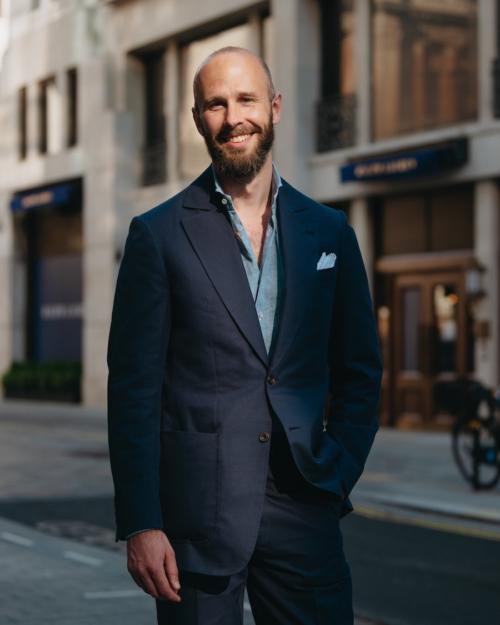
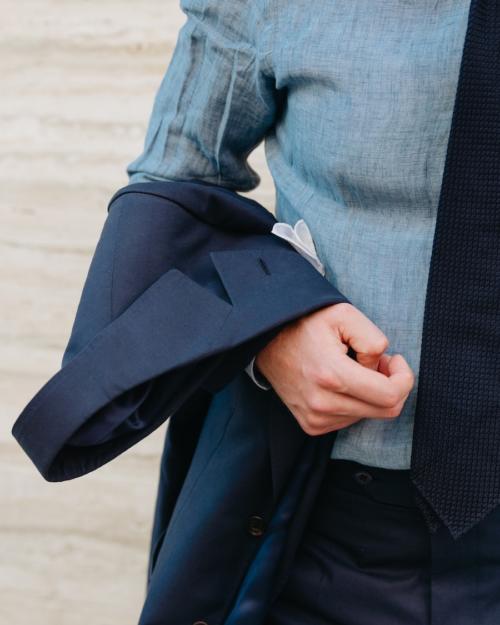
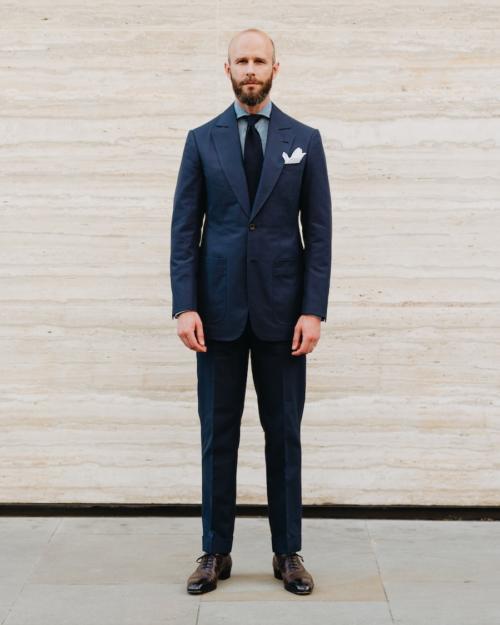
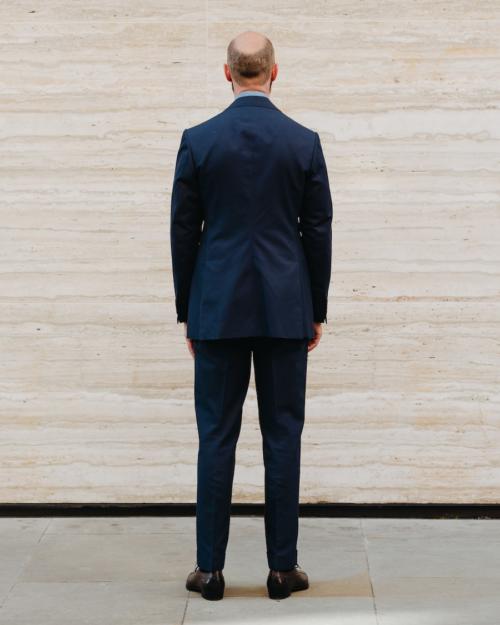
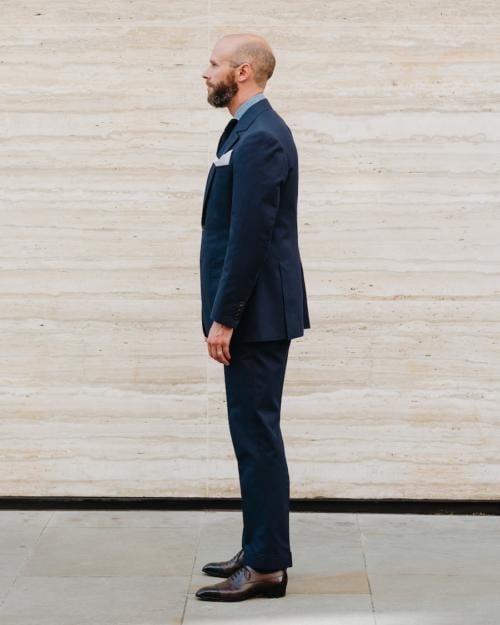
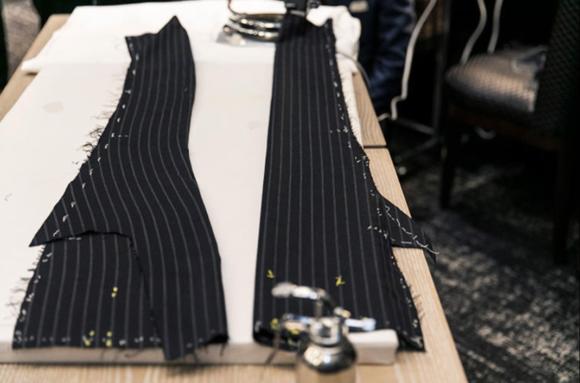
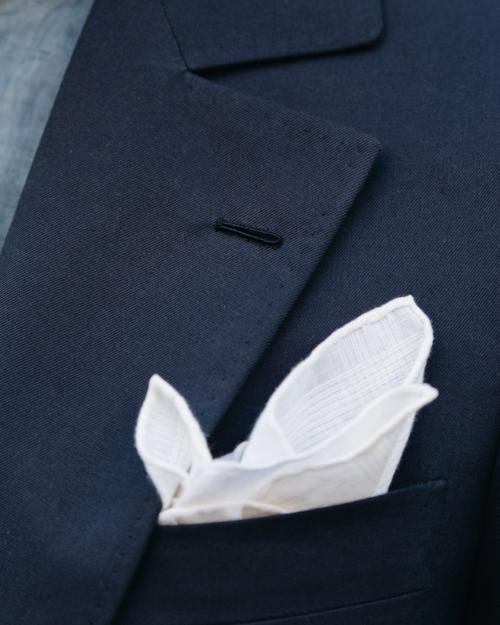
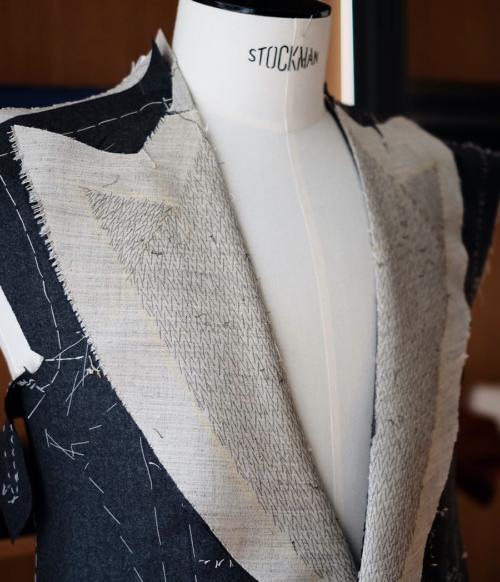
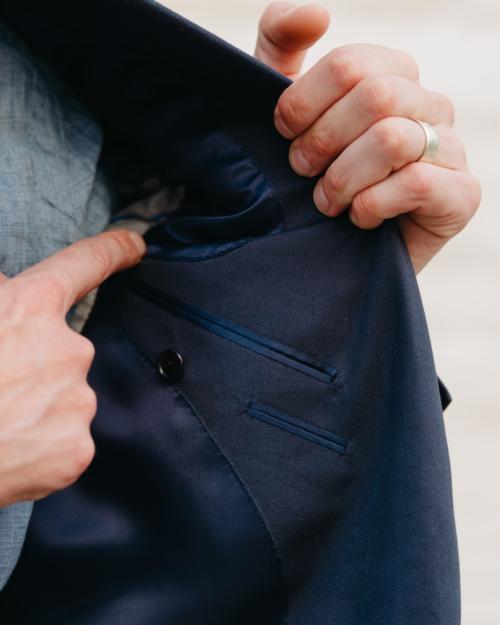
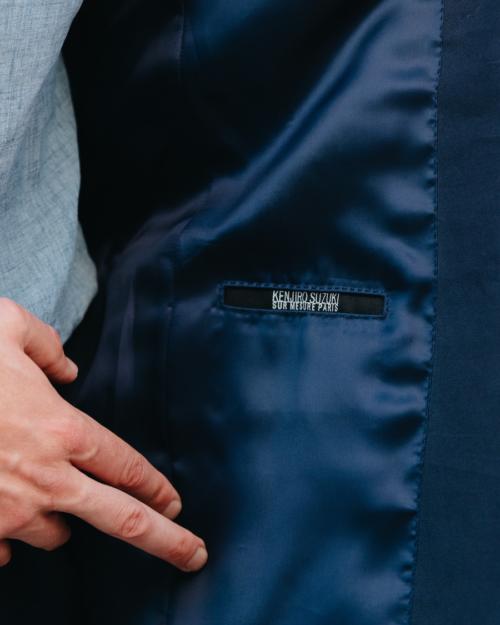
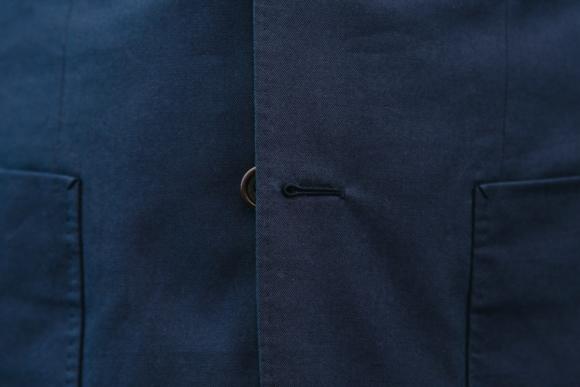
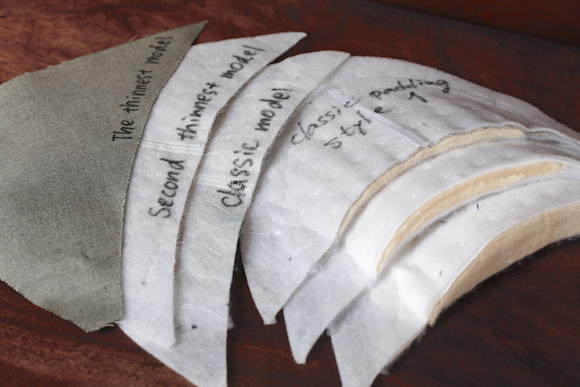
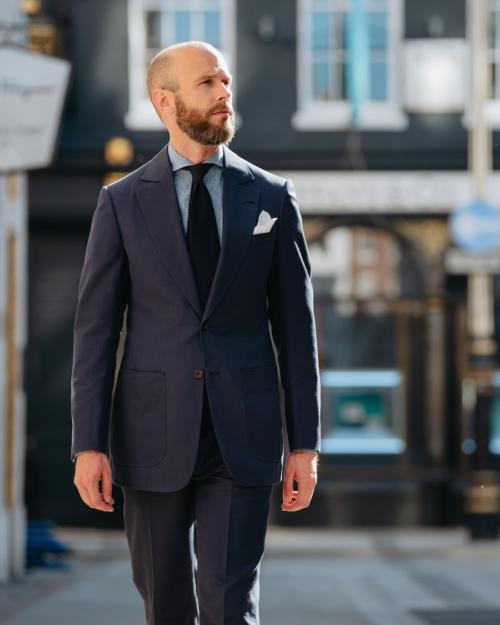

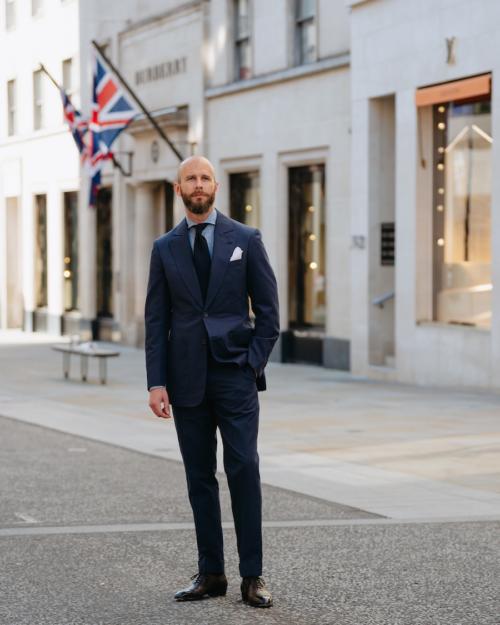
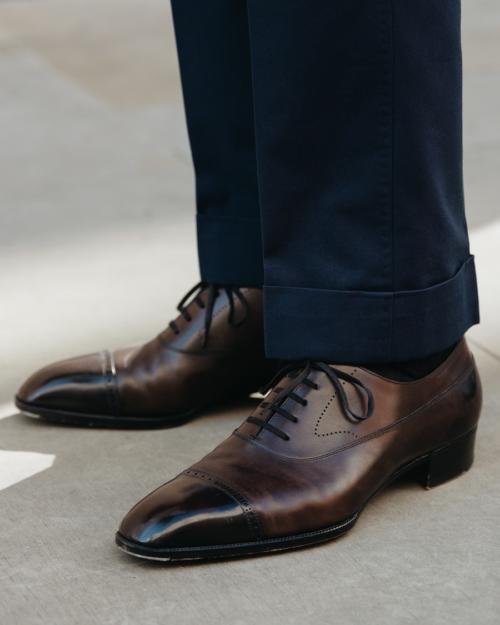


























I will trust your judgement on the craft so I will just say that it looks absolutely perfect. I’d go as far as saying this is my most favourite suit shape and style I’ve seen so far.
Great write up, Simon – I found the segment on the various types of padding particularly interesting. The suit as a whole looks lovely, however I personally find patch pockets on a suit jacket, even one in a casual cloth such as this, lends the jacket a bit of a bottom heavy look. The pockets do look very well finished, however.
Thanks Simon! What’s the point of so much shaping in cotton trousers?Wouldn’t this drop off in 1 week of wear?
Also do you find use for your newest japanese shoes? They seem very business-y and not suitable for casual stuff which is a pity considering the level of make.
Not that quick, and not completely, but you’re right they’ll soften more than wool
Yes I do find use for those. I would do so less in a black oxford, but dark brown is still good with smart jackets and trousers
Thank you, glad to hear that
Wow! That’s cheap for that kind of quality in Paris. Very impressive. Expected it to be €7k+. Looks very beautiful. For that level of workmanship he must be one of the best value either side of the channel.
Whilst I agree the front of the coat looks good, I am not a fan of the back. The horizontal ridge between your shoulder blades suggests tightness there, and the cloth is falling into the hollow of your back.
I’m interested in your comment about the neatness of the pick stitching though. I was always taught that this should be all but invisible if done well.
Thanks
Thanks Matt.
I’d hesitate to judge fit points like that from a photo, particularly with something like cotton.
On pick stitching, it is partly a question of style. Some want it to show
Thanks Simon.
Not sure I understand the answer; it seems ok to comment on good fit from a photo, but not bad?
Thanks
No, on neither really
Morning Simon
I’ve never been asked by a tailor if I want the pick stitches to be hidden or to show. If it is a style detail, should I request it next time?
Thanks
It will depend a little on the tailor and what they can do, but you could raise it if you have a view there, yes
Which do you prefer?
Interesting article. There’s a few points I would raise as follows. The length of the jacket looks about perfect to me – at the joint of the thumb – although you’ve stated its on the shorter side. Would you lengthen it?
In contrast to the jacket I feel that the trousers are to slim and also appear to be slightly to short.
Thirdly, you stated that the use of a thicker should pad was considered by the maker as cheating but this would have masked the dropped shoulder and evened them out. The picture from behind clearly shows one shoulder lower. This may not be an issue for you depending on preference but one of the great things about bespoke is being able to address these things.
Thanks for the questions.
Yes, I would maybe lengthen it slightly, but that’s all personal preference.
On the shoulder, he wasn’t saying it was cheating to even out the shoulders, just that he would rather do so with the cutting than by haven’t two different thicknesses of pad. (Not by having both thicker, as I think you’re saying.)
But yes, I don’t mind the shoulder looking lower, personally, as long as that doesn’t affect the balance below it on the front or back
I’m no expert in this area, but just thinking about your comments in other posts about house style – and here you mention the relatively high buttoning point, would this then mean the length he has cut it in-keeping with his style and a longer length may make the skirt look too much? For reference I think this is one of the nicest commissions I’ve seen, period!
Yes Jack, if I had had a longer length I would ask to lower the buttoning point too. Although he would probably do that anyway, without me asking, in order to maintain the proportions
Interesting and enjoyable post, thank you! Can you tell what cloth you used for the suit?
Holland & Sherry 9oz pure cotton. I can get the number
Simon,
What’s your thought on wearing a suit with an open neck shirt. I know you prefer a jacket and trousers with open necked shirts, does this only work with casual suits such as above?
I feel like it would only work with navy rather than grey, and shirt to be blue over white to soften the look.
Yes, I would only do it with more casual suits.
Grey might look a bit too smart, yes.
White might be ok as well. Though it always helps if it looks like the shirt has something else going on. Like a pattern, or maybe something like a one-piece collar
Hi Simon,
A very well made cotton suit, Are you able to provide the fabric code? Is it from the So cotton bunch Holland and sherry same bunch where you had the brown suit made by Elia Caliendo.
Yes, same bunch
I presume the colour is navy, although it looks a a few shades lighter and the colour is lovely even if its the natural daylight making it look lighter.
Yes I’d still call it navy, but that matte, dusty quality of cotton does make it look a little lighter
I lack the technical knowledge that some other readers do, but to my eye there’s only one word for this – outstanding.
It helps that navy is by far and away my favourite colour for anything, but even so.
A question on sleeve length; Aren’t the sleeves just a little long on this suit jacket? Or is this a conscious/style decision? Especially if comparing to the photos of the Moreau MTM linen suit, the Orazio pink jacket or the Ciardi gun-club jacket. I’m really wondering since I’m trying to decide for myself if I should slightly (0.5-1 cm) lengthen the sleeves in a MTM jacket I just received. Do you have a guide to sleeve length somewhere on the site?
Hi Johannes,
Good spot. It’s actually that the shirt sleeves are a little short. It’s a prototype of a new cloth we’re trying, and it had more shrinkage than we expected. So yes, I’d prefer another centimetre on each sleeve there.
Cotton tends to wrinkle and retain odors fare more than wool. How will this cotton fabric hold up to more frequent dry cleanings ? Is shrinkage or fading a concern ? Please advise. Thanks
I’ve had cotton suits for a good few years – most obviously for this suit, the one here by Choppin & Lodge
In my experience it will wrinkle more than most worsteds, but less than a linen or other lightweight summer cloths.
I haven’t noticed it retain odours more, though you’re right that would be expected.
There hasn’t been any shrinkage over time with cleanings, but there certainly is fading. You can see that on the crease of the trouser after just two or three cleans. For me that’s part of its charm – old cotton suits worn by, for example, the Prince of Wales, look lovely in that respect.
In fact, I’d be tempted to clean this more than the normal once a year in order to accelerate the effect.
“If I had to choose, I probably think the design of the Camps de Luca ‘teardrop’ pocket is more pleasing”
Would you ever ask another tailor to replicate the CdL teardrop? And if not, would it be because they couldn’t execute it, or because that would be copying?
No I wouldn’t, and it would be because it would be copying – also perhaps, a little insulting to the tailor you’re using.
I’d imagine it would be perfectly possible to replicate, albeit with a little work or trial and error if it hadn’t been done before.
On the topic of replication… I really appreciate the look of french “frog-mouth” lapels, however, I’m not fond of structured shoulders typical of French makers.
Given this, would you rather ask a French tailor like Kenjiro to cut his house style but with a soft, Ciardi-like shoulder or ask the Ciardi brothers to cut their house style suit with a frog-mouth lapel like Kenjiro? Or is this just an insane idea I have glorified in my mind after months in isolation?
Kenjiro does make a softer shouldered jacket, more unstructured and unlined, so you could ask him about that. But don’t ask him to just mimic another tailor’s style
Is it frog mouth or fish mouth?
Fish mouth, frog mouth is more usually for pockets
Beautiful suit, Simon! I have a question about the trousers, though. They have a lovely S shape, but wouldn’t it be a pain to press effectively? I always find that fine cotton trousers are very difficult to press at the crease line, given the material doesn’t keep it well. That fact makes me think that the S curve on the leg would make pressint at the crease line even more difficult.
You’re right, that is an issue. You can work the crease back in a little bit without removing that shape, but not entirely.
I guess there is a presumption that you might take the suit back to Kenjiro for a clean and press regularly too.
Hi Simon,
Do you normally dry clean your suits/tailoring once a year as a matter of course?
I try to keep dry cleani
ng to an absolutely minimum & steam garments after a couple of outings.
Unless you have a really excellent dry cleaner, I prefer to take the garments to a good tailor & have them sponged and pressed as necessary.
I find that it’s not so much the cleaning that does harm, it’s the pressing if not in expert hands.
I would appreciate your comments
Revgards
Stephen
Hi Stephen,
Yes, this is something we’ve covered a fair bit in the past, for example on this post.
I also steam my suits, but tend to clean them once a year before they go away into storage. Pressing is definitely the problem rather than the cleaning, but the cleaner I use, Michael Norman, knows his stuff.
Also, if you do have things dry cleaned, you can ask them not to press them, then take them to a good presser. There are even fewer of these around, but I used George the Presser, who does a lot for the Row.
I hope that’s helpful
A fine piece of work but don’t you think it would have been better to commission his ‘softest’ canvas for a suit in this cloth ?
It probably would have made for a more louche look.
As things stand, this risks to look like a formal suit in a casual cloth.
I can see what you mean Jason, but no I don’t think the canvas makes it look more formal. That’s more the cut.
Superb make, though I would prefer a slightly fuller and longer trouser and more suppression of the back. Is there any particular defining signature feature of a Suzuki suit that is obvious, such as Cifonelli shoulder etc? Would you say the level of make is of the same caliber of Cifonelli, CDL, C&M, and MB? If so, the price €4800 is outstanding (is it incl or excl VAT?), about 30% less expensive!
Not especially, but more because Kenjiro has a wider range of shoulder and lapel styles. If there is anything, it’s probably this deeper fish-mouth lapel, but he makes other styles as well.
Yes I would say it’s on the same level as those. Perhaps not Michael Browne, but it’s also different in emphasis too – more French finishing.
I’m pretty sure that’s with VAT, but you’ve made me doubt it now! I’ll double check with Kenjiro
Did you not make any payments towards this suit?
I generally don’t comment on what I paid for pieces reviewed. You can find more information on the policy on that topic here.
Checked and yes, it is with VAT included
Excellent value then for French tailor of this make!
Beautiful suit. May I ask what is the lapels width? Thanks.
I am away from home at the moment, but I’ll measure them next week and try to remember to report back.
This suit and cut looks really good on you which leads to my question – you place of lot of emphasis on stitching, finish etc. But surely at the end of the day, isn’t the main purpose of a suit not to attract attention to the clothes but to the person wearing it? There are some suits you’ve talked about where the fit might be right, tailoring perfect etc but you don’t look as ‘good’ say as the suit above. Point being are there cuts that are more flattering to you than others?
Hi Kali,
Yes absolutely. Most of the points around stitching and finish are not something that will attract attention – they’re very subtle, and a question of rating the quality of the work that’s gone into it.
And yes, some cuts are certainly more flattering than others on me. That tends to be something I discuss when comparing cuts across the Style Breakdown series, for example, rather than individual reviews of suits.
The lapel shape is not really to my taste, but that’s a great looking suit, and significantly lower in price than I was expecting. Those buttonholes are as good as it gets.
I can’t see why you’d want any extra length in the jacket. Seems like it would throw off the top/bottom balance.
Thanks Matt.
If the jacket were made longer (not now, but at an earlier stage, or a future commission) then the proportions would also be changed to keep the top and bottom balance
Fish-mouth lapel is an amazing style, that, unfortunately, doesn’t exist in ready-to-wear, and is seldom seen even in bespoke.
Hi Simon,
Thanks for your advice.
I spoke to Michael, a most charming man.
Thanks again
Kindest regards
Stephen
Oh good, nice to hear that Stephen
Hi Simon
Compare to the suit / jacket you owned, this jacket look like longer and bigger , especially on the bottom of the jacket (because of the button point?)
i mentioned this, because i have similar issue on my anthology LGB suit, is it kind of classic design?
I’m not sure exactly what you’re comparing it to – do you mean all others I own? It’s certainly not longer than others on average, or probably bigger.
The bottom half of the jacket is fairly large compared to the top, driven by the placement of the waist on the jacket (not necessarily the same place as the button position). This is a slightly more traditional cut among some tailors in the UK, which harks back to riding jackets. They like to make more use of the flattering shape of the skirt of the jacket, which is not an area most men are used to thinking about.
An amazing piece. Quite unbelievable that the shoulder pads are so minimal.
One hesitation is regarding the lack of mid-back suppression. A major benefit of the piece is how strong it makes your chest and back look, and I wonder if a more tapered back would detract from this. I suspect only minimally as no changes to the chest canvas would be necessary. In return, you’d get a much more pleasing profile silhouette, which currently looks a bit bulky to me.
I’m looking forward to the follow-up piece on the different shoulder shapes that can be made. Could you use some reference images like the one in this post – particularly the photo with the different pads – so we can follow along with what’s going under the cloth?
Sure. It might have to wait until I can get back to Paris, but certainly a good idea
Wouldn’t even know it’s a cotton suit if you didn’t tell me.
How do you feel about the buttoning point though, I feel, hum conflicted, might be my bias of prefer lower buttoning point
There’s a few comments from me on the buttoning point in the piece and above in comments.
Hi Simon, beautiful suit. This is definitely one of my favorite commissions of yours. I understand that you went for the ‘classic’ style so you may not have enough information to answer this question, but to the best of your ability, how would you say the ‘very soft’ and ‘unstructured’ styles compare to Neapolitan tailoring? As I’m a healthcare professional and want to be approachable and never too formal, I tend to wear jackets that are Neapolitan in construction or no jacket at all. I tried a ‘unstructured’ jacket at Loro Piana once but that seemed more like knitwear than tailoring. Do you think either the very soft or unstructured styles would be as good a choice as Ciardi or Caliendo for someone who wants tailoring that is very soft and casual? Thank you.
Hi Jonathan,
Yes, unstructured pieces from retailers usually mean with nothing inside at all – basically just knitwear in the shape of a jacket. That’s different to how we use it here.
I don’t really have enough information to answer on Kenjiro’s unstructured style I’m afraid, as I also didn’t try a piece on (I don’t believe there was one available).
But, I would say that you should never go to one tailor looking for another’s style. If you like Neapolitan style, go for that. Don’t go for Kenjiro to get something similar, if that makes sense. The cutting is a big factor in it all too, regardless of structure.
Thanks
Hi Simon, as mentioned on your Instagram post, I’d appreciate it if you could elaborate a little more on why you have tended to move away from this style with the higher waist, shorter jacket and bellied lapels, so that I can better understand what is achieved by the the change in styles. Thanks.
Hi Simon,
Sure. The higher waist tends to be favoured by tailors that draw on riding-jacket traditions, and emphasise the shape of the skirt of a jacket. I increasingly like ones that emphasise the top half more, because I find it more flattering and because I prefer the more open-chested style.
The other points are distinct from this really.
The shorter jacket I tend to err away from except in very casual jackets, and even there I’m tending to have them a little longer (ref. Ciardi).
The bellied lapels is something you see more with English and French tailors, and from a personal point of view I tend to prefer those that are cut straight, and so appear to roll outwards, like the Neapolitans.
However, that last point is more on casual jackets as well. I don’t mind it on smart jackets or suits.
I hope that helps
Worth pointing out perhaps that the skirt of riding jackets had little to do with buttoning points, chest shape and the like, and everything to do with the fact there needed to be enough cloth to allow you to sit comfortable on a horse.
Very true.
It’s a style that’s been continued since then because it was considered flattering in those respects though.
Well explained. Many thanks!
May I ask what is happening on the back flap? Why is it so caved in? It doesn’t happen on your cotton suit from Ciardi, nor on any other that I could remember.
I think that’s a pretty small thing, that you’d only notice when standing stock still like this. Things like that are also more noticeable on lightweight cottons like this (Ciardi was heavier and stiffer)
Great review. Very interested in this cloth. Thanks very much. I have seen a rtw fishmouth lapel style at the armoury if I’m not mistaken…
I’m just missing a few pictures or comments about the trousers. If I’m one of the few who has interest in seeing the trousers on its own and hearing some feedback about them when reviewing a suit then nevermind but it would be interesting especially because these relatively slim trousers make this suit look more modern than a lot of your savile row suits. So there is a difference for sure. It’s makes a huge difference in comfort too. Thanks.
Cheers, and yes I often don’t have time to speak in much detail about trousers. Perhaps it’s something that would benefit from a bigger, comparative piece at some point looking at different tailors
The work on this suit looks immaculate and I think the style really suits you, Simon.
Immediately comes across as razor sharp.
If you start lengthening the jacket through the back center seam, through the middle back through to the bottom, it will clean up a lot of that strange messiness you see in the photo.
Thank you. As ever, I think it’s hard to give specific advice based on a single photo. Particularly given how many cutters I see that change their mind when they see something in person. But always nice to have the input.
Isn’t the left leg slightly shorter than the right leg ?
I don’t think so, no, but it’s a good point – it does look like that a little. I will go and look again just to be sure
Simon, given the casual nature of cotton as a material for suits and the modern slim cut of the trousers how would you feel about wearing the suit without a tie and sockless, perhaps wearing a pair of Sagans?
I’d be fine with that, personally. It would be ideal if the suit were a slightly more casual cut, but I still think just about ok, given the cloth
Would be interesting to see some examples of the fading of the cotton over time. Maybe a “great things age” covering some of your cotton suits?
Nice idea, yes. Thanks P
Do you think the tapered, somewhat narrow, trousers seem disproportionate to the jacket? I like well tailored, tapered trousers but these trousers strike me as out of proportion with the jacket which throws off the balance between jacket and trousers.
Perhaps. I can certainly see your point. I think it looks OK myself, just because the jacket looks so controlled and straight in its lines, if that makes sense, and the trousers do too.
I should have made this clear in my post: the suit is a beautiful piece of work and looks great. My comment is offered only in the context of getting hooked on bespoke and now embarking on the quest to find the great white whale of the perfect bespoke suit! Love your site and your work.
Congrats on the suit. It is very well balanced and the tailoring looks amazing.
Hi Simon, overall, what would be your recommendation for a first cotton suit in terms of fabric weight and colour?
I’d say something like this, 9oz, to be nice for warmer weather but some of the rest of the year too.
Colour depends a little on your lifestyle and wardrobe. I’d say either a navy like this for smartness, or a dark-olive green or light brown for something more casual.
Glad to see that the pocket square is back in favour with you Simon, after a short hiatus. Definitely gives the whole look here a bit of pop.
Thanks Chip. It’s certainly not gone away, just more a choice than a default
Are you going to do a style breakdown of this suit? I’m curious to know how the shoulders, chest, and waist compare to suits from Suzuki’s fellow Parisians.
Probably not in the near future I’m afraid Stanford. But certainly at some point
In which case, may I ask you to briefly respond here whether, compared to Cifonelli and Camps de Luca, Suzuki’s shoulder is wider or narrower, his waist more or less suppressed, his chest more or less stiffly canvassed?
The chest varies a lot depending on what you want – see above on the available thicknesses.
I’d say the waist is less suppressed, but that depends on the customer heavily too.
The shoulder line is very similar
Thank you, Simon.
This material is extremely critical of a Tailors work. In addition the canvas require very skilled handling. I noticed the attention to detail most on the padding of the lapel especially the change of direction for the point – in this case the French version of a Frogmouth.
It is a great piece of work but I just don’t get why you would spend so much on a garment that if it were made in a woolen material would have given a result that would easily exceed the work commonly found on Savile Row.
Because I also have lots of beautiful wool suits already, partly.
And I like cotton, for its casualness and subtlety. And hard as it is to work, a bespoke version would always be better than any non-bespoke one.
Hello who on earth stitched the back of that navy blue suit jacket, its all puckered.
How did you miss this such a poor advertisement.
I’d caution against concluding anything like that from one static photo John. Time and again, it proves inaccurate. The photos are only there to illustrate points I’m making – having seen the suit in person
Hello Simon. Who made the pocket square you’re wearing? Could it be Simonnot-Godard? Thank you.
Hi. It’s from Anderson & Sheppard, but it may well still have been made by SG
Simon, I keep on coming back to this suit – really very stylish! If you were to wear this suit in a bank office environment, would you go for flap pockets? On the other hand, the patch pockets may make it easier to wear this kind of suit more casually without a tie, e.g., to a reception in the evening. Any thoughts? As always, many thanks, Jan
I think I would go with flap pockets, yes Jan.
Hi Simon, This is my favorite suit of yours on the website. In the article you mentioned that the shoulders are natural in this suit. Does the French style of suits with natural shoulders sit between English and Italian in terms of formality or would you say it is as casual as Neapolitan suits ?
No, between the two, and probably verging more towards the English. There’s less padding but still real shape and sharpness to them and the body and make overall
Simon. I heard Suzuki San moved back to Japan – are you able to attain any updated information regarding pricing, delivery time & location in Japan?
I know cost of living & such in Japan is much lower than Paris (and rent) – wondering if that impacts the price.
I don’t have anything, no sorry